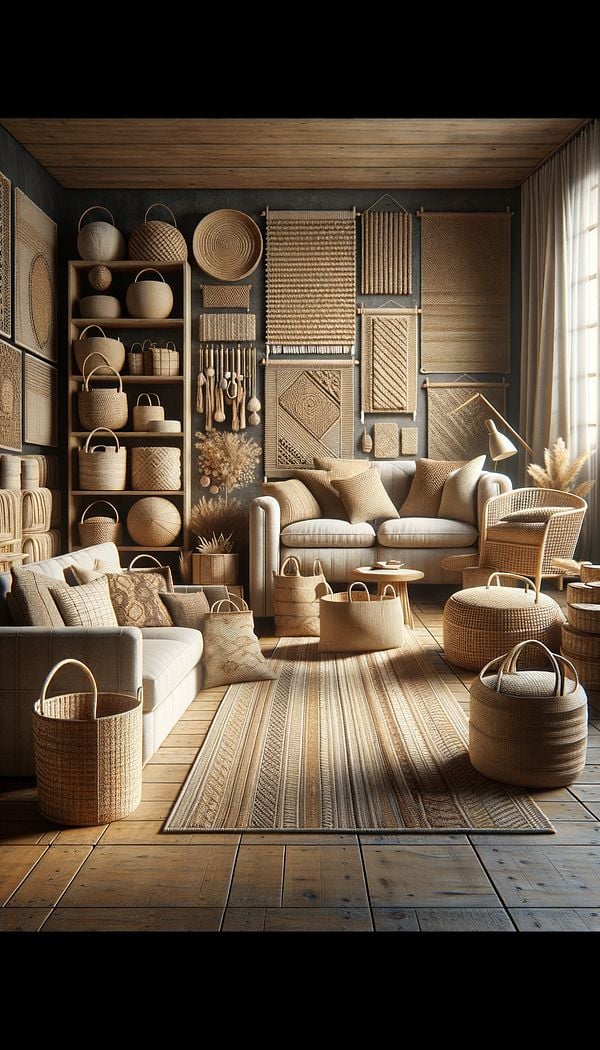What is Jute?
Jute is a long, soft, shiny vegetable fiber that can be spun into coarse, strong threads.
Description
Jute is a highly versatile natural fiber known for its exceptional strength and breathability. Harvested from the bark of the white jute plant (Corchorus capsularis) and, to a lesser extent, from the tossa jute plant (Corchorus olitorius), it is one of the most affordable and eco-friendly fibers available. With a golden, silky shine, often earning it the moniker "the golden fiber," jute fibers are primarily spun into strong, coarse threads subsequently used in various applications across the home interiors and furnishings industry.
In the context of interior design, jute is celebrated for its rustic yet refined texture and its natural color, which effortlessly adds warmth and organic appeal to any space. It's an excellent choice for eco-minded or sustainable design themes, aligning with the broader industry trend towards materials that are both beautiful and kind to the planet. Jute's uses in interior design range from being the primary material for rugs and carpets to serving as the basis for wall coverings, upholstery fabric, and various decorative objects.
Moreover, the material's strong yet breathable nature makes it suitable for high-traffic areas within homes or commercial settings. Its inherent texture and color variations add a unique touch to every piece, ensuring that no two jute-based items are exactly alike. Interestingly, beyond its aesthetic and practical applications, jute also plays a role in improving indoor air quality by regulating humidity levels, showcasing its multifaceted benefits in interior environments.
Usage
In home decor, jute is often found in the form of area rugs, floor coverings, and carpets. Its natural beige color and distinctive texture lend a casual, earthy vibe, making it a popular choice for layering with other rug materials to create depth and interest. Jute fabric is also used in upholstery and window treatments, offering a touch of natural beauty and sustainability to interior spaces. Decorative items such as baskets, lampshades, and wall art crafted from jute further showcase the material’s versatility and appeal.
FAQs
-
Is jute durable?
Yes, jute is naturally strong and durable, making it ideal for items in high-traffic areas of the home. However, it is sensitive to moisture and direct sunlight, so care should be taken in its placement and maintenance.
-
Can jute be dyed?
Absolutely, jute can be dyed in a variety of colors, although its natural beige tone is a significant part of its appeal. Dyeing can enhance its versatility in design schemes.
-
How should jute products be cleaned?
For most jute items, regular vacuuming and spot-cleaning with a damp cloth are recommended. Avoid using too much water, as jute is highly absorbent and can be prone to mildew.
-
Is jute environmentally friendly?
Jute is considered one of the most eco-friendly fibers available. It is biodegradable, recyclable, and grows quickly with minimal need for fertilizers or pesticides.
-
Where does jute come from?
Jute is primarily grown in the Ganges delta, spanning across Bangladesh and parts of India. The ideal growing conditions include high humidity and temperature.
Practical Application
When incorporating jute into your interior design scheme, consider its natural, rustic charm and texture as a counterpoint to more modern or polished elements. Jute rugs and carpets can anchor a room with their earthy tone, while upholstered pieces add a touch of sustainable luxury. For care, vacuuming jute regularly and addressing spills promptly with a dry cloth will help maintain its beauty and longevity. Remember, jute thrives in dry, well-ventilated spaces, so it's best suited away from bathrooms or damp areas.
-
Decorative Objects240 articles
-
Textile Techniques10 articles
-
Materials & Textiles360 articles
-
Flooring & Carpets48 articles
-
Sustainability & Eco-Friendly Design69 articles
-
SisalSisal is a natural fiber derived from the Agave sisalana plant, used extensively in the interior design field.
-
Hope ChestA hope chest is a storage chest traditionally used to collect items such as clothing and household linen, by unmarried young women in anticipation of married life.
-
RusticRustic refers to a design style that embraces natural, rugged, and aged elements to create an authentic and earthy feel.
-
ChenilleChenille is a soft, fuzzy fabric known for its luxurious texture.
-
LinoleumLinoleum is a durable, eco-friendly floor covering made from natural materials.
